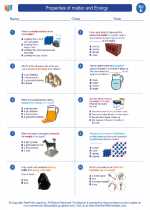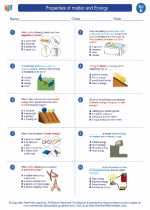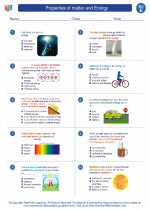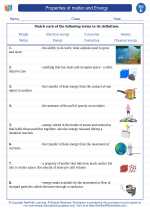Properties of matter and Energy -> waves
Waves
Waves are a fundamental concept in physics and can be found in various forms throughout the natural world. They can be described as disturbances that travel through a medium. There are several types of waves, including mechanical waves, electromagnetic waves, and matter waves.
Types of Waves
Mechanical Waves: These waves require a medium, such as air, water, or solids, to travel through. Examples of mechanical waves include sound waves and seismic waves.
Electromagnetic Waves: These waves do not require a medium and can travel through a vacuum. Examples of electromagnetic waves include light, radio waves, microwaves, and X-rays.
Matter Waves: These waves are associated with the motion of particles at the quantum level, such as electrons and other subatomic particles.
Properties of Waves
Waves have several key properties, including:
- Amplitude: The height of a wave, which determines its intensity.
- Wavelength: The distance between two successive crests or troughs of a wave.
- Frequency: The number of waves that pass a given point in a specific amount of time.
- Speed: The rate at which a wave travels through a medium.
Wave Behavior
Waves exhibit various behaviors when they encounter obstacles or pass from one medium to another, including reflection, refraction, diffraction, and interference. Understanding these behaviors is crucial in understanding the way waves interact with their environment.
Applications of Waves
Waves have numerous practical applications in everyday life and various fields of science and technology. These include communication technologies (such as radio and cellular signals), medical imaging (such as X-rays and ultrasound), and the study of the universe through the detection of cosmic waves (such as gamma rays and gravitational waves).
Study Guide
To effectively study the topic of waves, it is important to familiarize yourself with the following concepts:
- The different types of waves and their properties
- Wave behaviors, including reflection, refraction, diffraction, and interference
- The mathematical relationships between wave properties, such as the speed of a wave, its frequency, and its wavelength
- The practical applications of waves in various fields
It is also helpful to engage in hands-on activities and experiments to observe wave phenomena firsthand and reinforce your understanding of the concepts.
By mastering the principles of waves, you will gain a deeper appreciation for the role they play in the natural world and modern technology.
[Waves] Related Worksheets and Study Guides:
.◂Science Worksheets and Study Guides Fifth Grade. Properties of matter and Energy

 Worksheet/Answer key
Worksheet/Answer key
 Worksheet/Answer key
Worksheet/Answer key
 Worksheet/Answer key
Worksheet/Answer key
 Vocabulary/Answer key
Vocabulary/Answer key
 Vocabulary/Answer key
Vocabulary/Answer key
